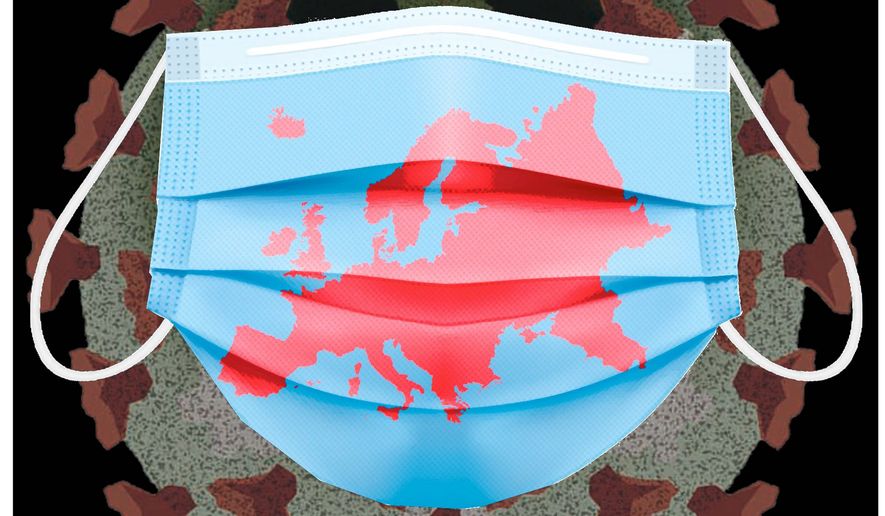OPINION:
The pandemic is again raging in Italy, where strict lockdowns and widespread mask-wearing were once believed to have tamed the contagion.
On Nov. 8, Italy’s health ministry reported a record 39,809 new cases — more than six times the number of daily cases recorded at its peak last spring. On a per capita basis, that’s twice as many new cases as detected in the U.S. that day.
The resurgence of COVID-19 in Italy and throughout the West points up an unpleasant truth about our public health strategy: lockdowns + mask-wearing + “wait for a vaccine” does not sum to a solution.
Stubborn adherence to that plan by U.S. and European public health officials has left us with no effective response to the current spike. Plan A has failed.
We need a Plan B — one that relies on existing technology. That plan? Let people use rapid tests they can read at home to learn if they are infected.
This summer, public health experts held up Italy as a model for dealing with the contagion. On July 7, MedPage Today reported that becoming “the next Italy,” a fearsome fate during the spring, had become “a prospect that now seems welcome.”
The first country to impose lockdowns, Italy enforced them more strictly and left them in place longer than most other nations. Its national mask mandate is enforced by military police, with fines recently increased to 1,000 euros per violation.
Just a month ago, the narrative held that, because European governments stuck with lockdown orders and Europeans complied with mask mandates, they beat the pandemic, and the U.S. did not.
But with cases mounting throughout Europe, we don’t hear that story anymore. The dreaded “second wave” of the virus is cresting both in countries that religiously practiced lockdowns and mask-wearing and in those whose citizens were less observant.
While the experts predicted the second wave, they didn’t prepare for it. Instead, they’ve stuck with Plan A: Bring back the lockdowns.
Italy seems to be slouching in that direction, although Italians seem less inclined to capitulate this time around. Prime Minister Giuseppe Conte has not yet ordered a national lockdown. His approval ratings, though still positive, have trended steadily downward since early October, when infection rates began their steep ascent, and he is reluctant to revive policies many Italians oppose.
Instead, his government has issued a series of emergency orders, the most recent of which imposes lockdowns only in regions with high infection rates that meet certain criteria, including increases in cases and hospitalizations. That, of course, is precisely contrary to the recommendations of lockdown enthusiasts, who counsel invoking those orders before case rates climb and leaving them in place long after those rates have abated.
That path is no longer politically feasible throughout much of Italy and the U.S. Nor is it an effective solution, as the resurgence of cases in lockdown countries shows.
The lockdown strategy, like mask mandates, rests on ignorance. Since we don’t know who is infected, we treat everyone as though they were infected, shuttering schools, businesses and churches and keeping our distance from others. Since we don’t know if we ourselves are infected, we act as though we are, wearing masks in hopes of reducing the chance of infecting others. Tragically, once we confirm an infection, we advise the infectious person to stay home and expose family members to the disease.
Plan A doesn’t work. It’s time to consider Plan B.
Plan B would base policy on information, not ignorance. It would start with FDA approval of self-tests for COVID-19. Such tests require only a saliva sample on a paper strip and yield rapid results. They cost only a few dollars to produce and don’t require laboratory analysis, enabling broad population screening at low cost.
Such tests, which can be produced at the rate of tens of millions per day, can be used in homes, offices, businesses and schools. Studies show that widespread screening can be an effective tool, even accounting for the tests’ lower accuracy rates. Those who test positive should undergo more accurate testing to confirm or rule out a COVID-19 diagnosis.
By screening millions of people daily, we arm them with information they need to protect themselves and others.
Having identified the infected, we should then help them separate from the uninfected. Most COVID-19 transmission occurs in the home. Affected communities should consider establishing voluntary isolation centers. Hotels would be suitable venues for these purposes. Those with confirmed diagnoses should be encouraged (but not compelled) to protect their families by using these facilities. The government should pay those who voluntarily remain isolated until they are cleared of infection.
Former Vice President Joe Biden has posted a website that endorses “at home tests and instant tests” that will “scale up our testing capacity by orders of magnitude.” If he’s referring to rapid self-screening tests, President Trump should join him in calling on the FDA to approve them.
• Doug Badger is a visiting fellow in Domestic Policy Studies at The Heritage Foundation.




Please read our comment policy before commenting.